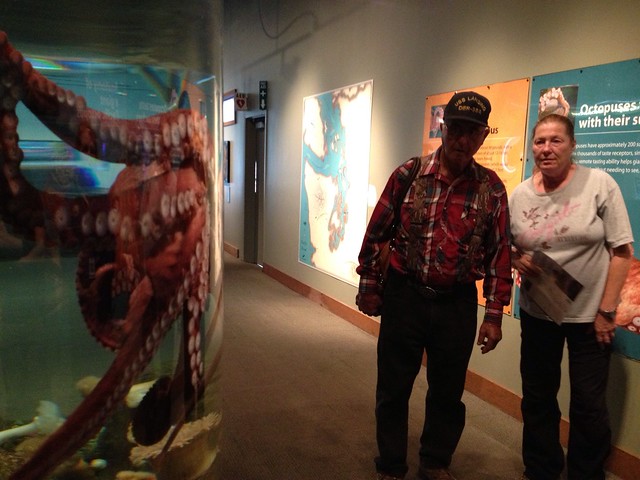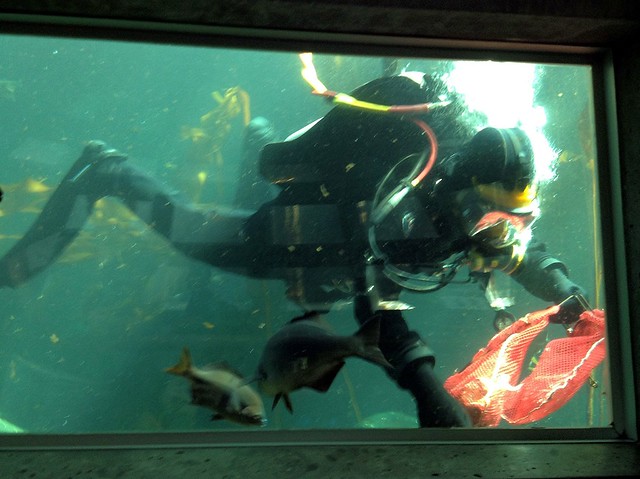“Aren’t you pretty?” the woman cooed. “Look at you, you’re the sweetest thing!” She pressed her hand up against the glass, simulating contact. “Oh, you sweet thing!” she said.
“They’re not usually this social,” said the volunteer. “This one’s got quite the personality. She’s very curious. Usually, they hide, they’re solitary by nature. But this girl… she’s different.”
The animal blinked and moved; I watched it breathe. The woman followed the animal along the curve of the glass to the artificial rocks and cooed some more. “You’re just gorgeous,” she said, over and over. The critter could not hear her, or if she did, it was highly unlikely she understood either the words themselves or the message.

This failure to communicate was probably because the animal in question was a forty pound cranberry colored octopus. She’d been moved from the aquarium’s holding tanks out on to the main floor that day — this was the octopus’ first day out in public. She pressed up against the glass, swirling her suckered tentacles, blinking at the semicircle of people that stood around listening to the volunteer answer questions.
The big octopus are native to Puget Sound and they get to be freaky big. This one replaces a male octopus that was recently released back into the wild. The Seattle Aquarium has a history of capturing octopuses, bringing them into the aquarium for study — and to breed — and then returning them to the waters of Puget Sound.
The Seattle Aquarium isn’t big, but I enjoy the visit every time I’m there. I never get tired of watching the puffins perform their antics and the tanks are all so beautiful. It’s also nice that many of the tanks and displays are so firmly rooted right here in our own local ecology — I love being able to ask questions about what I see when I’m tide-pooling on our own shores. Almost every summer since I’ve lived in West Seattle, I’ve had the good fortune to chat with one of the Aquarium’s volunteer beach naturalists at low tide — they’re on the beach near my house armed with lots of marine biology knowledge and laminated books that tell you what’s what, especially that unidentifiable gooey thing.
Before it became apparent that I had no facility with math — a critical skill for a scientist — or being at sea — I get seasick — I wanted to be a marine biologist. I am still completely fascinated by what lives in the waters and I love that aquariums let me take a good long look at the critters that call the oceans their home.

Practical stuff: The Aquarium was the last stop we made on our attempt to use up a pair of comped CityPASS books — without a CityPASS, it’s 21.95. That same day, I also used up the last of a Starbuck’s gift card I had kicking around. The aquarium is on the downtown waterfront, so you’ll have to pay downtown parking rates, there’s no getting around it. There are four hour zones under the viaduct, though, so at least you don’t have to rush out and refuel the meter. That said, if you’re planning to spend a good chunk of time downtown, take public transit and save your money. There’s no shortage of places to grab a bite or snack nearby, but if you’re going full on tourist, go to Ivar’s Acres of Clams, just south of the Aquarium. It’s been there since the 30s, the views are great, the food is exactly what you’d expect from a seafood house, and it’s not stupidly expensive. Plus, it’s fun.
Related: Also on the CityPASS, a trip to Seattle Center and the Woodland Park Zoo.

Aquariums are fascinating places as they allow you to view a great deal of marine life that is often alien to us land dwelling mammals! It can be surprising just how different and alien a lot of the creatures seem but always deeply interesting.